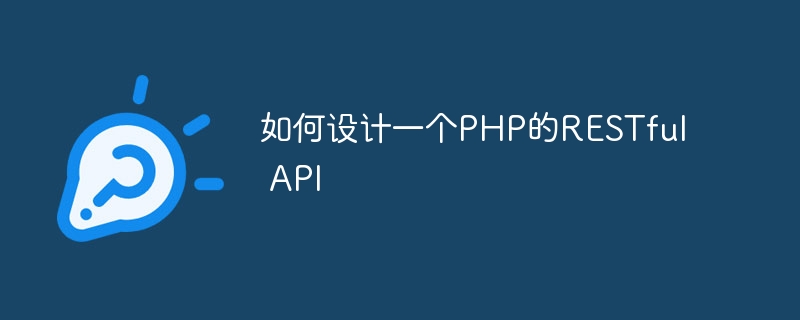Home >Backend Development >PHP Tutorial >How to design a RESTful API in PHP
How to design a RESTful API in PHP
- WBOYWBOYWBOYWBOYWBOYWBOYWBOYWBOYWBOYWBOYWBOYWBOYWBOriginal
- 2023-09-05 13:36:311267browse

How to design a RESTful API for PHP
RESTful API (Representational State Transfer API) is an architectural style commonly used in modern web application development. It is very suitable for data transfer between different clients and servers, and has good scalability and maintainability. As a popular server-side programming language, PHP provides a wealth of tools and frameworks to build RESTful APIs. In this article, we will introduce how to design a RESTful API based on PHP. Below are specific steps and code examples.
- Design API resources and endpoints:
When designing a RESTful API, you first need to determine the resources and related endpoints to be exposed. Resources can be any entities, such as users, articles, products, etc. Each resource should be unique and identified by a URI. Endpoints are methods used to operate these resources, such as obtaining resources, creating resources, updating resources, and deleting resources. Here is an example of a user resource:
Resource: Users
Endpoint: /users
- Use the appropriate HTTP method:
RESTful API Use HTTP methods to perform different operations. Commonly used HTTP methods are GET, POST, PUT and DELETE. Here are the operations each method is typically used to perform:
- GET: Used to obtain information about a resource. For example, get information for all users or get information for a specific user.
- POST: used to create new resources. For example, create a new user.
- PUT: used to update existing resources. For example, update a user's information.
- DELETE: used to delete resources. For example, delete a user.
- Building Routers and Controllers:
Using a PHP framework to build a RESTful API can improve code organization and maintainability. Most PHP frameworks provide routing and controller functionality. Here is a sample code using the Laravel framework:
Define the route:
Route::get('/users', 'UserController@index');
Route::post('/users', 'UserController@store');
Route::put('/users/{id}', 'UserController@update');
Route::delete('/users/{id}', 'UserController@destroy');Write the controller:
class UserController extends Controller {
public function index() {
// 获取所有用户的信息并返回
$users = User::all();
return response()->json($users);
}
public function store(Request $request) {
// 创建一个新的用户并返回
$user = new User;
$user->name = $request->input('name');
$user->email = $request->input('email');
$user->save();
return response()->json($user);
}
public function update(Request $request, $id) {
// 更新特定用户的信息并返回
$user = User::find($id);
$user->name = $request->input('name');
$user->email = $request->input('email');
$user->save();
return response()->json($user);
}
public function destroy($id) {
// 删除特定用户并返回
$user = User::find($id);
$user->delete();
return response()->json(['message' => 'User deleted']);
}
}- Return the appropriate HTTP status code:
When processing requests, it is important to return appropriate HTTP status codes. Here are some common HTTP status codes:
- 200 OK: Successful GET request.
- 201 Created: Successful POST request.
- 204 No Content: Successful PUT or DELETE request, but no content was returned.
- 400 Bad Request: The request is invalid or incomplete.
- 404 Not Found: The requested resource does not exist.
In each routing method, use the appropriate HTTP status code and response to indicate the result of the operation.
The above is the design and implementation process of a basic PHP RESTful API. Of course, there are many other aspects to consider in the design of RESTful APIs, such as authentication, data validation, version control, etc. With this foundation, you can further expand and optimize based on your specific needs. I hope this article can provide you with some help in designing and building your own RESTful API.
The above is the detailed content of How to design a RESTful API in PHP. For more information, please follow other related articles on the PHP Chinese website!

